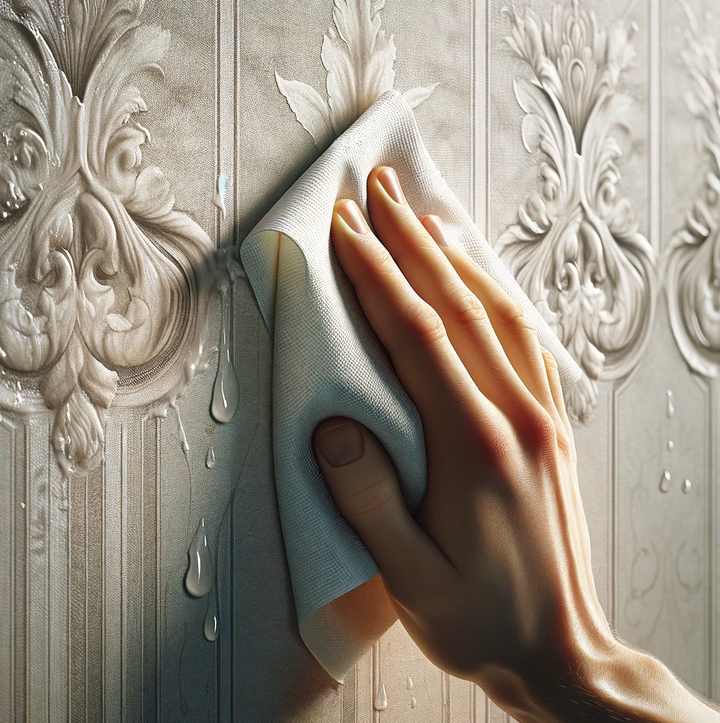
Learning how to clean a wall mural is crucial to maintaining its vibrancy, longevity, and overall appeal. This article offers a comprehensive guide to various cleaning methods categorized into two: sensitive cleaning methods and deep cleaning methods. You’ll also learn some tips for wall mural maintenance. But first, you’ll have to start with the initial process, which is dusting.
The initial step: Dusting
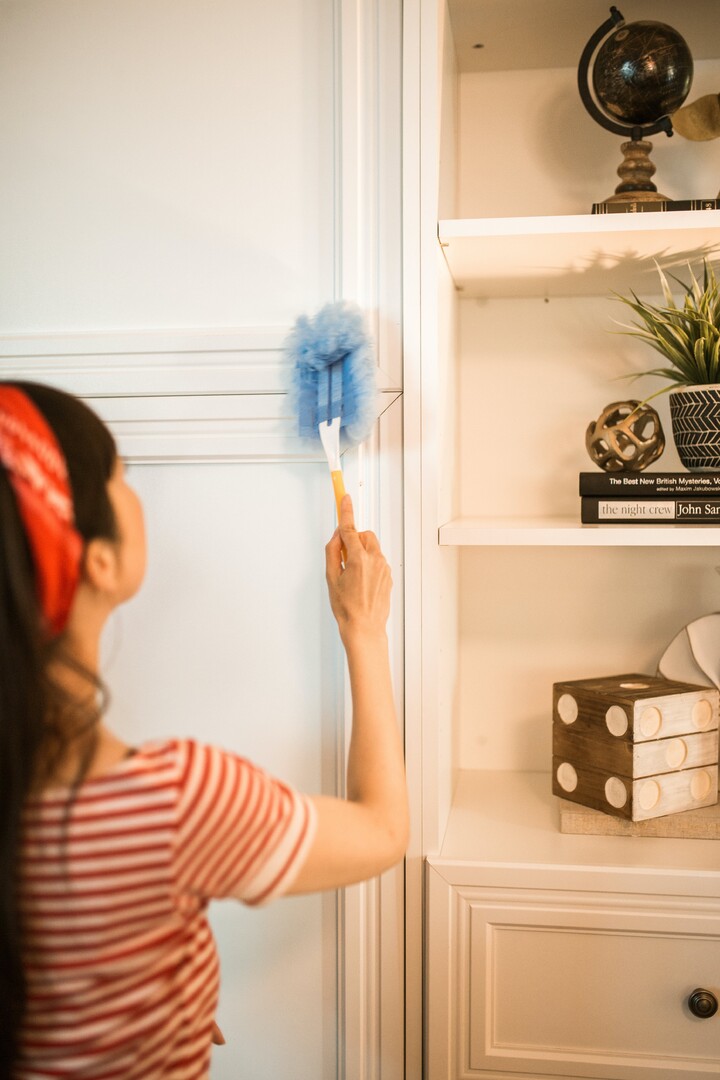
Dusting is an essential first step in cleaning any wall mural. Maintaining a regular dusting routine can help preserve the mural's vivid colors and intricate details. Here are two convenient ways to dust your wall murals:
Through a soft duster
1. Ensure that your duster is clean and free from any debris. A dirty tool can introduce scratches to the mural surface.
2. Start from the top of the mural and work your way down in gentle, sweeping motions.
3. Ensure to dust the edges and corners, as these areas accumulate more dust.
4. If using a cloth, occasionally shake it out or switch to a clean side to avoid reapplying dust.
Through vacuuming with a brush attachment
1. Make sure the vacuum is set to a low suction setting. Too much suction can damage the mural.
2. Attach the soft brush attachment to the vacuum hose.
3. Starting from the top, gently vacuum the mural in horizontal sweeps, moving down as you go.
4. Pay special attention to corners and edges, removing accumulated dust without applying too much pressure.
After dusting your wall mural, you may choose a cleaning method that suits your mural’s condition. We have categorized them into two, as shown in the following sections: the sensitive and deep cleaning methods.
Sensitive cleaning methods
Sensitive cleaning methods emphasize gentle techniques for cleaning wall murals, ensuring the removal of dirt and stains for the mural's intricate designs. There are three sensitive cleaning methods in this section, and you may choose what’s most suitable for your wall mural’s condition or your preference. In each section, you’ll know what materials are suitable with the method and easy-to-follow steps on how to do it properly.
1st sensitive cleaning method: Using a dry cloth wipe

Using a dry cloth for cleaning is one of the most basic yet effective methods. It's particularly suitable for light cleaning when there is minimal dirt. This method mainly removes smudges or light fingerprints without introducing cleaning agents or water to the mural.
Suitable wall mural materials
• Cellulose
• Fabric
• Bamboo
• Hybrid
• Removable Peel-and-stick
• Non-woven wall mural
• Vinyl
• Fiberglass
Easy-to-follow steps
1. Choose a soft, lint-free cloth. Microfiber cloths are an excellent choice for this method.
2. Ensure that the cloth is clean and free from any previous cleaning residues.
3. Begin from the top of the mural, working your way down in gentle, sweeping motions.
4. Focus on areas with visible dirt or smudges, applying light pressure to lift the dirt.
5. Regularly shake out or switch to a cleaner part of the cloth to prevent reapplying dirt or smudges.
6. Inspect the mural from different angles to ensure you've effectively removed dirt and dust without causing any abrasion.
2nd sensitive cleaning method: Using a soft sponge with water
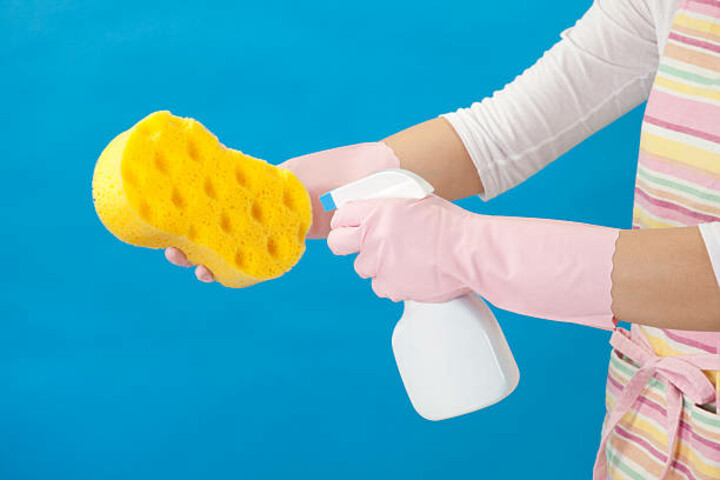
Using a soft sponge dampened with water offers a gentle way to cleanse your wall mural of light stains or accumulated dirt. This method avoids using chemicals, ensuring a mild cleaning process that respects the delicate nature of most wall murals.
Suitable wall mural materials
• Fabric (preferably those treated to resist moisture)
• Cellulose
• Bamboo
• Peel-and-stick
• Non-woven
• Vinyl
• Fiberglass
• Hybrid
Easy-to-follow steps
1. Choose a soft sponge that is free from any abrasive surfaces.
2. Dip the sponge into clean, room-temperature water.
3. Wring out the sponge thoroughly to ensure it's damp, not soaking wet.
4. Starting at the top of the mural, gently wipe in a circular motion, working your way down.
5. Pay attention to visibly soiled areas, applying gentle pressure to lift off the dirt.
6. Frequently rinse the sponge in clean water and wring out the excess moisture.
7. After cleaning, allow the wall mural to air dry naturally. 8. Ensure there's good ventilation to speed up the drying process.
8. Once dried, inspect the mural for any remaining spots and clean them as needed.
3rd sensitive cleaning method: Using a mild detergent solution

For murals that have been exposed to more persistent dirt or light stains, a mild detergent solution can provide the extra cleaning power you need without using deep cleaning methods. When selected and used correctly, a gentle detergent can break down the grime, leaving your wall mural looking refreshed and vibrant.
Suitable wall mural materials
• Bamboo (with caution, test a small inconspicuous area first)
• Cellulose
• Fabric
• Premium non-woven
• Vinyl
• Fiberglass
• Hybrid
Easy-to-follow steps
1. In a bucket, mix a small amount of mild detergent with lukewarm water. The solution should be barely soapy to the touch.
2. Dampen a soft cloth or sponge in the detergent solution.
3. Wring out the cloth or sponge thoroughly so it's damp but not dripping.
4. Starting from the top, gently wipe the mural using a circular motion, gradually working your way down.
5. For tougher stains, allow the detergent solution to sit for a few minutes before gently scrubbing the area.
6. Frequently rinse the cloth or sponge in clean water, wring it out, and continue cleaning.
7. Once you've cleaned the entire mural or the targeted area, use a separate cloth dampened with clean water to rinse off any residual detergent.
8. Pat the cleaned area with a dry towel or let the mural air dry, ensuring good ventilation in the room.
9. Review the cleaned surface for any missed spots or residues and address as needed.
Deep cleaning methods
Deep cleaning methods address the stubborn stains and accumulated grime that can build up from daily wear and tear. In each section, you’ll learn which materials are compatible with the method and get step-by-step instructions for effective cleaning.
1st deep cleaning method: Using a vinegar solution
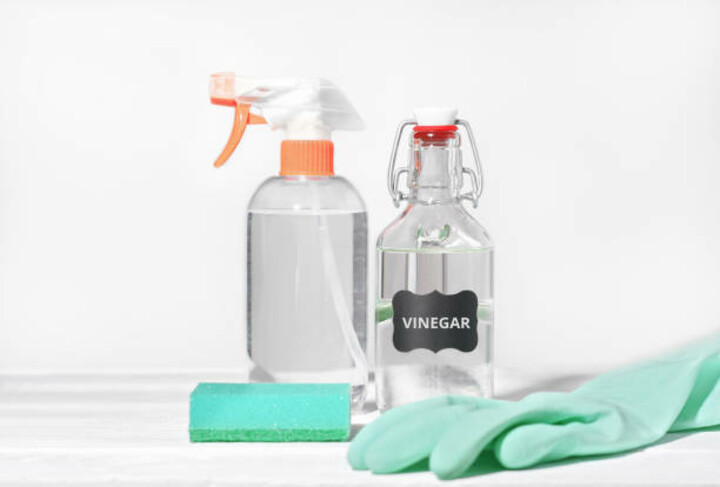
Vinegar is a popular household cleaning agent known for its disinfecting properties and ability to break down tough stains. When diluted with water, vinegar offers a safe and eco-friendly method to clean wall murals without the use of harsh chemicals. It's especially effective for tackling mold, mildew, and other stubborn marks that can accumulate over time.
Suitable wall mural materials
• Vinyl (with caution, as prolonged exposure can affect adhesive qualities)
• Cellulose (test a small inconspicuous area first due to potential color fading)
• Fiberglass
• Hybrid
Easy-to-follow steps
1. Prepare a solution with equal parts of distilled white vinegar and warm water in a bucket or spray bottle.
2. Using a spray bottle, lightly mist the solution onto the targeted area. For a bucket, dampen a soft cloth or sponge in the vinegar solution.
3. Gently rub the stained area in a circular motion, avoiding soaking the wall mural.
4. Allow the vinegar solution to sit on the stain for 5-10 minutes for stubborn spots, but don't let it dry on the mural.
5. Dampen a separate cloth with clean water and wipe down the area to remove any vinegar residue.
6. Pat the area with a dry towel to remove excess moisture or let it air dry. Ensure there's proper ventilation in the room to expedite the drying process.
7. After drying, check the mural for any lingering stains and repeat if necessary.
2nd deep cleaning method: Using soap and warm water
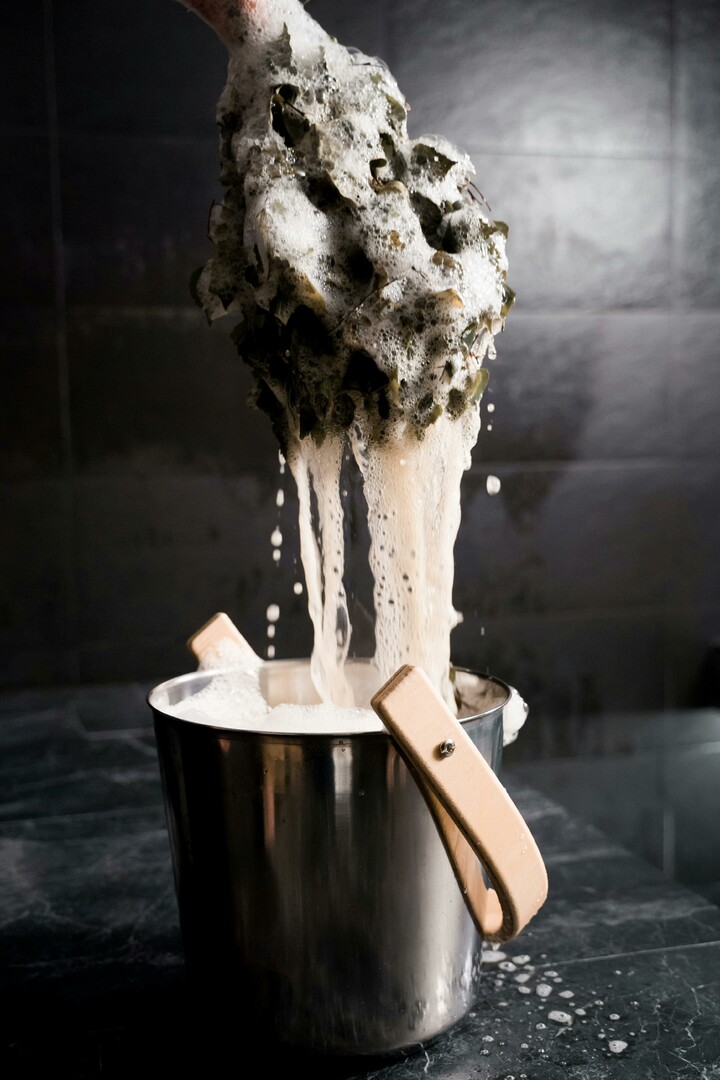
Using soap and warm water is a tried-and-true method for cleaning many surfaces, including wall murals. It's ideal for removing general dirt, greasy fingerprints, or other smudges that may not come off with just a dry cloth or mild detergent. The warmth of the water, combined with the gentle cleaning properties of soap, can effectively break down common household stains without causing damage when used correctly.
Suitable wall mural materials
• Vinyl (ensure not to oversaturate; excess moisture can affect adhesive qualities)
• Cellulose (always test a small hidden area first, as soap might cause slight discoloration or affect texture)
• Fiberglass
• Premium non-woven
• Hybrid (test a small inconspicuous area first due to the varied nature of hybrid materials)
Easy-to-follow steps
1. In a bucket, mix a few drops of mild soap (like dish soap) with warm water. Stir until suds form.
2. Dip a soft cloth or sponge into the soapy water solution.
3. Wring out the cloth or sponge to ensure it's damp but not dripping.
4. Begin cleaning from the top of the mural and gently wipe in circular motions, working your way down.
5. For tougher stains or soiled spots, apply a bit more pressure, but avoid aggressive scrubbing that could damage the mural's design or texture.
6. Rinse the cloth or sponge frequently in clean water and reapply the soapy solution as needed.
7. Once the mural is cleaned, rinse it with a cloth dampened with clean water to remove any soap residues.
8. Use a dry, soft towel to pat down the mural, absorbing any excess moisture.
9. Allow the wall mural to air dry completely. Ensure there's good ventilation in the room to help with the drying process.
10. Inspect the mural for any missed spots or residues and clean them as needed.
Tips on how to maintain your wall mural

Maintaining the pristine appearance and longevity of your wall mural involves more than just cleaning. A proactive approach can prevent damage and ensure your mural remains as vibrant as the day it was installed. Here are some essential tips for optimal wallpaper maintenance:
Periodic checks and addressing minor issues:
Routine inspections of your wall mural can help identify and rectify minor damages before they escalate. Whether it's areas where the mural might be peeling, discolorations, or minor scratches, addressing these issues promptly will ensure the mural's integrity and appearance. Early detection and intervention will help you save both time and money. For guidance on fixing common wall mural damages such as seams, air bubbles, and peeling, refer to this detailed guide: How to fix wall mural seams
Keeping the environment around the wall mural controlled:
Wall murals, like many home installations, respond to the environment they're in. Consider the following environmental controls:
• Humidity: High levels can lead to wall mural peeling or mold growth. Use dehumidifiers in damp areas or ensure adequate ventilation, especially after cleaning or during rainy seasons.
• Direct sunlight: Prolonged exposure to direct sunlight can fade the colors of your mural. If your mural is in a place that receives a lot of sunlight, consider installing shades, blinds, or UV-protective window films to shield it from the sun's harshest rays.
• Temperature fluctuations: Extremes in temperature can affect the adhesive properties of your mural. Try to maintain a consistent temperature in rooms with wall murals.
Regular maintenance combined with a proactive approach will not only keep your mural looking fresh but also extend its life, allowing you to enjoy its beauty for many years to come. Nevertheless, if you think that your wall mural has come to the point that mere maintenance is not enough, if your walls need more than just cleaning, and your room requires a dramatically new and fresh look, head over here: how to install a wall mural
Do's
• Test in an inconspicuous area: Prior to applying any cleaning solution, always test it on a small, hidden portion of the mural to ensure no discoloration or damage occurs. This will help you choose the best cleaning method for your wall mural, may it be a deep or sensitive cleaning method.
• Always read manufacturer guidelines: Before you begin cleaning, refer to any care instructions or guidelines provided by the mural manufacturer or artist.
• Use soft materials: When cleaning, opt for soft cloths, sponges, or brushes to avoid scratching or damaging the mural surface.
• Rinse thoroughly: If you use any cleaning solutions, ensure you rinse the mural with clean water to remove any residues that can cause damage over time.
• Dry properly: After cleaning, gently pat the mural with a soft towel or cloth to absorb excess moisture, and let it dry completely in a well-ventilated area.
Don'ts
• Don't oversaturate: Be cautious not to apply too much water or cleaning solution, as excessive moisture can deteriorate the mural's adhesive qualities or the mural material itself.
• Avoid abrasive materials: Avoid hard brushes, scrubbing pads, or any abrasive tools that can scratch or harm the mural's surface.
• Don't rush: Cleaning a mural isn't a race. Take your time gently cleaning the surface, ensuring you don't cause any inadvertent damage.
• Avoid cleaning under direct sunlight: If possible, don't clean the mural under direct sunlight, as the sun can accelerate the drying process and cause streaking or uneven drying.
Advantages of Photowall

Photowall stands out by providing wall murals that merge durability with ease of maintenance. Their non-woven offerings resist sunlight fading, ensuring that the vibrancy of designs and colors remains unaffected over time – a boon for those prioritizing effortless upkeep. These non-woven murals are effortlessly cleaned with a simple damp cloth. Moreover, choosing their premium wall murals benefits you from their compatibility with cleaning products. Additionally, Photowall's peel-and-stick wall murals boast resistance to surface stains and are easily wipeable. Such features highlight Photowall's dedication to products that harmoniously combine functionality, longevity, and aesthetic charm.
 Australia
Australia
 Austria
Austria
 Belgium (Dutch)
Belgium (Dutch)
 Canada (English)
Canada (English)
 Denmark
Denmark
 Estonia
Estonia
 Finland
Finland
 France
France
 Germany
Germany
 Ireland
Ireland
 Italy
Italy
 Luxembourg (French)
Luxembourg (French)
 Netherlands
Netherlands
 New Zealand
New Zealand
 Norway
Norway
 Poland
Poland
 Portugal
Portugal
 Romania
Romania
 Singapore
Singapore
 Spain
Spain
 Sweden
Sweden
 Switzerland (French)
Switzerland (French)
 USA
USA
 United Kingdom
United Kingdom
 Other Countries
Other Countries




